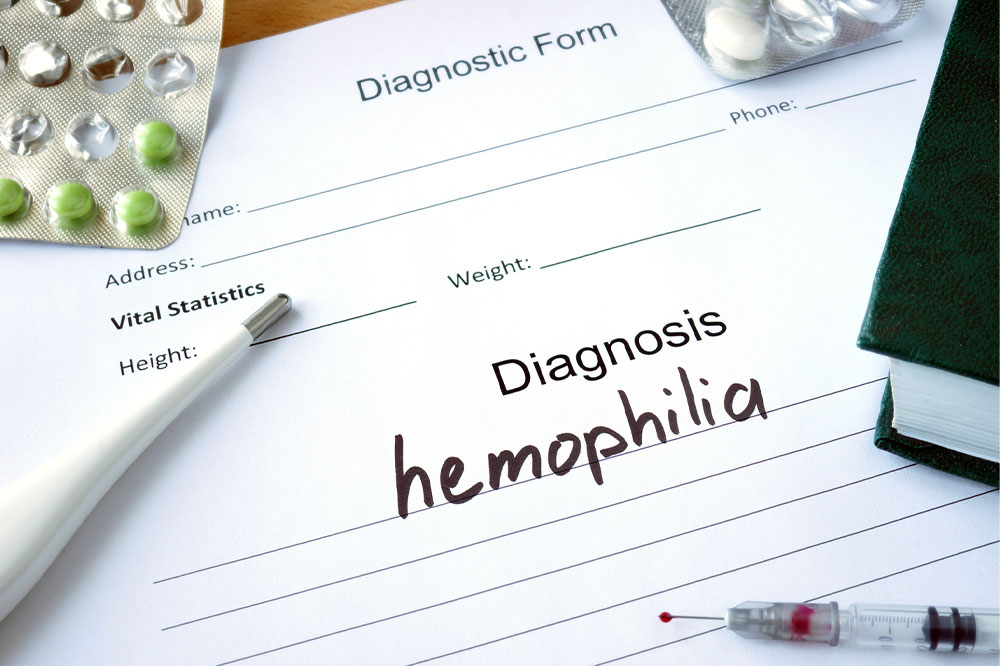Hemophilia – Symptoms, Types, and Management Options
The human body functions systematically. All the organs and tissues work in perfect synchronization. When injured in an accident, a specific mechanism turns on to control bleeding through the process of blood clotting. However, in a few people, the blood cannot clot properly due to missing clotting factors, making it impossible to control the bleeding. As a result, the patient bleeds profusely and spontaneously. This bleeding disorder is called hemophilia.

What is hemophilia?
Our blood contains proteins known as clotting factors, which are responsible to stop the bleeding after a cut or injury. Hemophilia is a rare genetic disorder in which an individual’s blood does not clot normally because of fewer clotting factors. Therefore, they are prone to intense bleeding when they get wounded after an incident.
The bleeding due to this disorder is not only limited to external wounds but also internal organs. If the kidney or stomach develops a cut, it does not heal quickly, increasing the risk of internal bleeding. Hence, the one requires specialized hemophilia treatment and professional care to ensure the blood clots normally to stop the bleeding in time.
Symptoms of hemophilia
The common signs and symptoms of hemophilia are:
Abnormal bleeding in the joints, resulting in swelling and pain
Accumulation of blood under the skin
Bleeding after circumcision
Occasional bleeding of the mouth and gums, especially after losing a tooth
Bleeding after vaccines or other shots
Blood in the urine or stool due to complications in the kidney
Frequent bleeding and nosebleeds that are difficult to treat
Bleeding in the throat that causes swelling and interferes with the normal breathing process
Heavy bleeding in the head of an infant after birth
Besides the above, there could be instances of bleeding in the brain in rare cases. It can result in permanent damage, disability, and even death.
Types of hemophilia
There are different types of this health condition:
Hemophilia A
Hemophilia A, the most common type, occurs due to an insufficient amount of clotting factor VIII. It is passed down from parents to children, but one-third of cases are due to a gene mutation. It causes both internal bleeding (in joints and muscles) and external bleeding (minor cuts or trauma).
Hemophilia B
Also called Christmas disease, hemophilia B is caused due to an insufficient level of clotting factor IX. Like hemophilia A, one-third of cases are caused by a sudden mutation in specific genes. Individuals with this condition tend to bleed for longer than usual.
Hemophilia C
Hemophilia C happens due to the lack of clotting factor XI, which causes only extended bleeding after surgery, trauma, or dental procedures. It affects both men and women equally.
Acquired hemophilia
Acquired hemophilia can develop later in life when the immune system mistakenly attacks the clotting factors in the body during an infection or disorder. It could be associated with cancer, multiple sclerosis, and pregnancy.
Causes of hemophilia
This rare disorder is primarily genetic or inherited, indicating that it passes through generations of defective genes or chromosomes. It is usually linked to the abnormality of X chromosomes. However, researchers have found that only 50 percent of people with hemophilia have acquired it from their family genes, and the others have no hereditary factors. It means the disorder might result from a change or mutation in genes even though nobody in the family has or has had the condition.
Treatments for hemophilia
While there is no cure, several hemophilia treatment options are available to manage the disorder. It usually requires a team approach from healthcare professionals from different verticals, including hematologists, physical therapists, dentists, orthopedic surgeons, and more.
The initial step in treating hemophilia is to replace the missing clotting factors so that the blood clotting process will be carried on properly. This process can be done by two methods:
Plasma-derived factor concentrates
In this procedure, doctors extract clotting factors from a donor’s blood. They are usually derived from the plasma, a pale-yellowish liquid part of the blood. The clotting proteins are then processed to produce a powder, which is infused during therapy.
Recombinant factor concentrates
This new hemophilia treatment uses advanced technology to make clotting factors. Here, the blood clotting proteins are made in a lab and not derived from a donor. The therapy can treat both current bleeding and prevent future complications.
Several new treatments for hemophilia patients continue to emerge, thanks to research and health technology. Gene therapy is one such alternative. It helps the body to make its own missing clotting factors rather than administering them externally from a donor. However, the research for this new hemophilia treatment is still under trial.
Hemophilia is incurable and can lead to life-threatening situations if not diagnosed early. The best hemophilia treatment is usually determined based on its type and severity. Nonetheless, comprehensive therapy helps prevent severe health complications in the future and ensures patients lead healthy and normal lives.